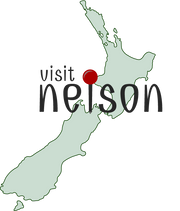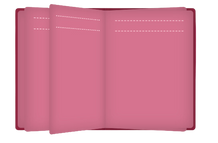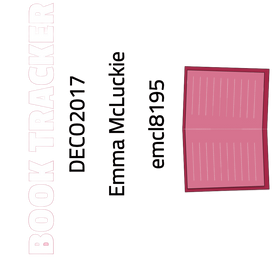EM
MCLUCKIE
Hi, my name is Em!
I'm a third year interaction design student at the University of Sydney.
I'm looking to start my professional career in web development, UX, UI or product design.
UX/UI PROJECTS
Interactive Installation
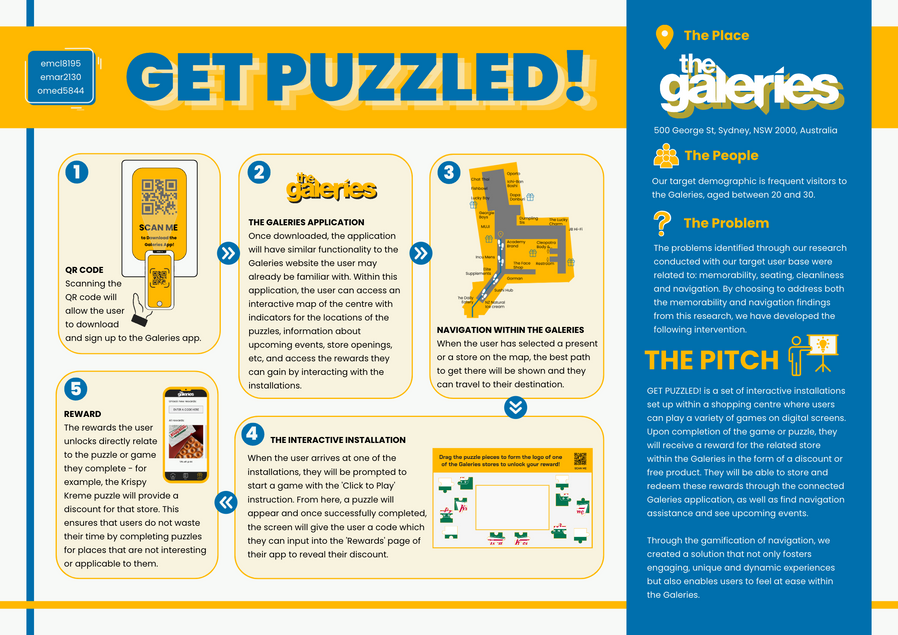
As a group, using the idea of playful cities, design a physical, digital, and spatial interactive installation.
WEB DESIGN PROJECTS
GET PUZZLED: User Experience

DECO2014 - User Experience Studio | |||
Project | Public Interactive Installation | ||
Brief | Using the idea of playful cities (the intersection between play and the urban environment), design an interactive installation for a location of your choice, that is physical, digital, and spatial. NOTE: This project was completed with Eva Mary Arun & Olga Medvedieva. | ||
Requirements |
| ||
Skills |
| ||
Final Product | Our final product, GET PUZZLED! is a set of interactive installations set up within a shopping centre where users can play a variety of games on digital screens. The installation will also be connected to an application, where the user can see an interactive map of the centre with indicators for the locations of the puzzles, information about upcoming events, sales, and store openings, and access the rewards they can gain by interacting with the installations. The installations will have different digital and interactive games and upon completion, the user will receive a code to redeem a reward at a participating store within the Galeries. | ||
Process | |||
RESEARCH Background Research - As a group, we researched the overall topic of shopping centres, including the issues users were having, the changes to shopping centres and the experience since COVID-19 began, and design precedents of installations in shopping centres around the world. Research Questions - We outlined our research questions as:
Questionnaires - The questionnaire was a mix of 12 open and closed ended questions with 46 participants. The aim of this questionnaire was to determined users experiences with the Galeries shopping centre including what encourages them to spend time, their satisfaction with particular offerings, and how they spend their time when they are there. Contextual Observations - We conducted three contextual observations in the centre on different days of the week with the aim of seeing how people travelled through areas, group sizes, pace (motivation), and any other noticeable behaviours. Interviews - We conducted six semi-structured interviews, all of frequent visitors to the Galeries. The aim of the interviews was to get more in depth information about experiences in the centre and find out where issues were arising in some key areas of shopping experience including seating, crowdedness, navigation, and cleanliness. Insights - As a group, we determine used an affinity diagram to turn our findings into four main insights: 1. Design interventions need to keep time in mind, as the turnover rate inside the Galeries is high. 2. Wayfinding needs to be improved. 3. There is a demand for inclusive seating spaces catering to a variety of needs. 4. The shopping experience has to be engaging, unique and varied. | |||
ANALYSIS AND SYNTHESIS We used a persona and a customer journey map to further understand the needs of our potential users. Additionally, we used the 5 Whys method to help us reframe and improve our initial problem statement: "to investigate how to design for engaging, unique and dynamic experiences at the Galeries" | |||
SOLUTION IDEATION Initially, we did a quick mindmap to make sure we understood our insights, then we each developed three storyboards of potential solutions for our problem. From here we each picked our best solution for navigation and for unique engagement and used a decision matrix to score these based a selection of criteria including addressing insights, ease of use and accessibility, and whether it would be achievable to build and test. Our first solution option was an AR application which assisted users in navigating the Galeries while encouraging them to earn points by finding special statues around the centre. We completed a modified version of Crazy 8's to quickly design screens which could be used in our application. From here we looked at all the designs and selected elements we liked and sketched a condensed version of the features we liked. We went through a number of iterations while trying to balance the briefs requirements of playfulness that is also physical, digital and spatial. Our final iteration of the product needed to be more playful and therefore it became an installation where instead of scanning statues, visitors can play physical games in order to earn rewards and discounts for stores within the Galeries, access through our original application concept. TESTING For our testing fair, we developed wireframes which would become these mockups, as well as a physical cardboard, paper, and magnet prototype of our final design concept. We tested our product with users given three specific tasks and utilised the six usability goals, including effectiveness, efficiency, and learnability. We asked follow up questions about their experience and the product, and had each participant complete an SUS evaluation. Although, we only achieved a "B" grade in this evaluation, it gave us some very useful guidance on how to iterated on our product for the final, high fidelity submission. The main feedback related to a disconnect between the physical games and digital interface and intuitiveness of the physical puzzles. FINAL ITERATION Our final product, GET PUZZLED! is a set of interactive installations set up within a shopping centre where users can play a variety of games on digital screens. The installation will also be connected to a Galeries application. Within this application, the user can see an interactive map of the centre with indicators for the locations of the puzzle, information about upcoming events, store openings, etc, and access the rewards they can gain by interacting with the installations. The installations will have different digital and interactive games and upon completion, the user will receive a code to redeem a reward at a participating store within the Galeries. | |||

Name: Mia | Occupation: Student UTS, Japanese minor |
Age: 19 | Home: Lives near Central |
Scenario: It is a Friday afternoon. Mia is supposed to meet with some friends for drinks at Town Hall in the evening. She decides to find a book that she needs for her Intro to Japanese class in the meanwhile. Using google she learns that there is a wide variety of Japanese language materials available at Kinokuniya bookstore which is located in the Galeries, which is in the area. She decides to leave early and try to get the materials that she needs before meeting her friends. | |
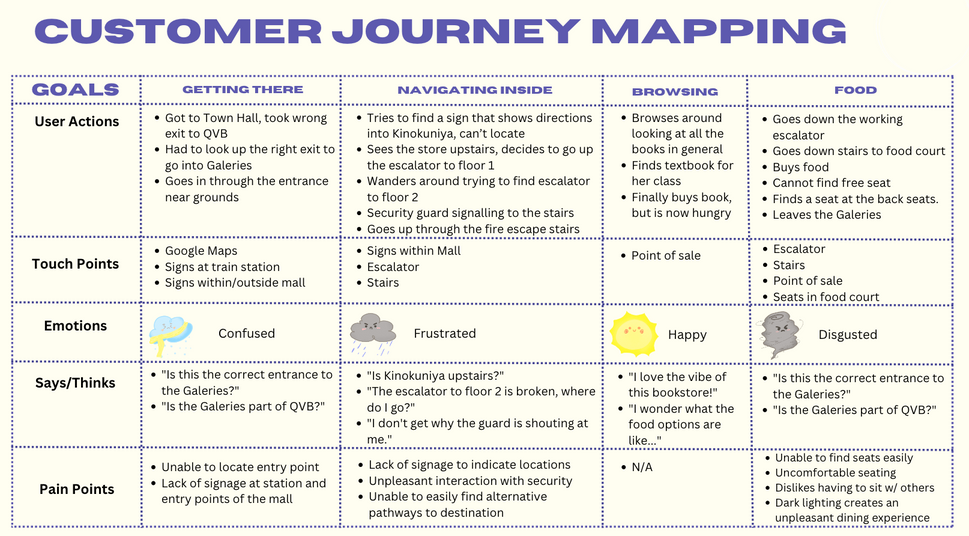
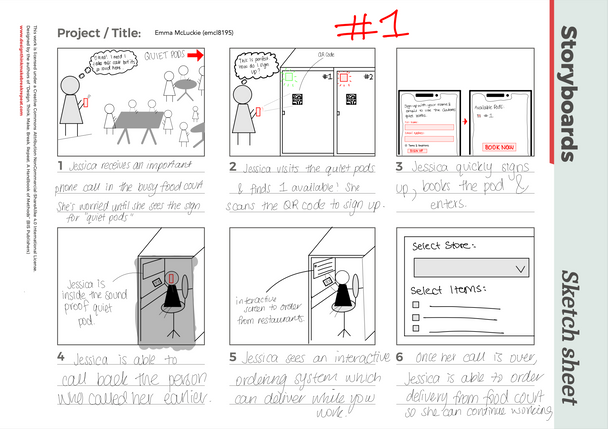
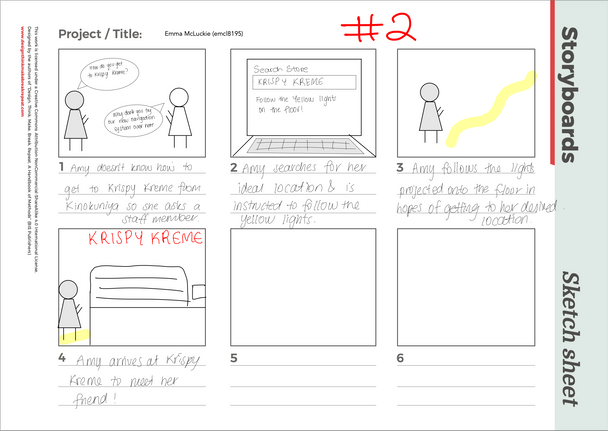



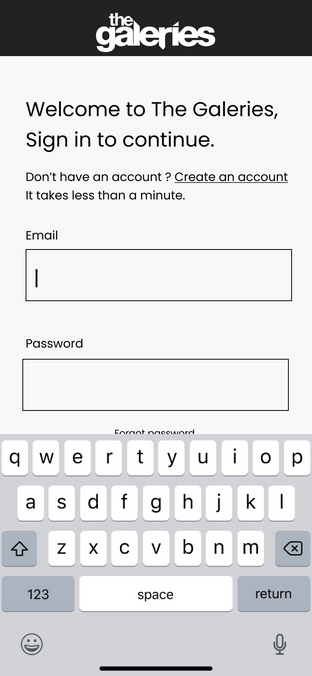


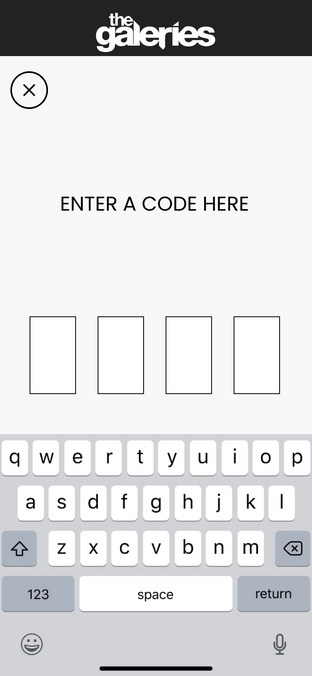
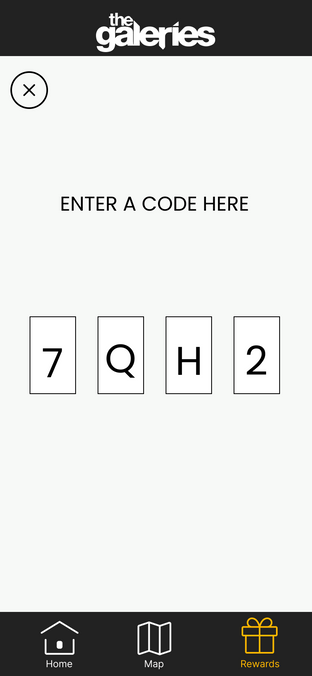

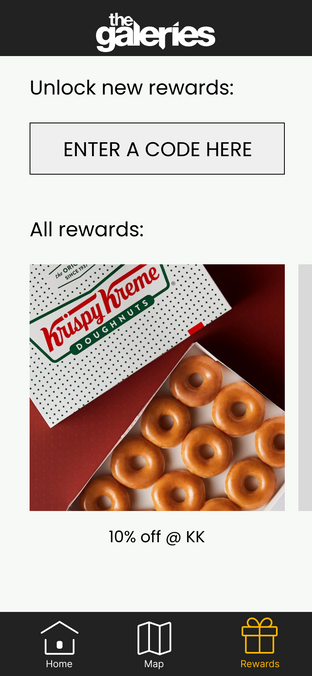

LEVEL UP: User Interface
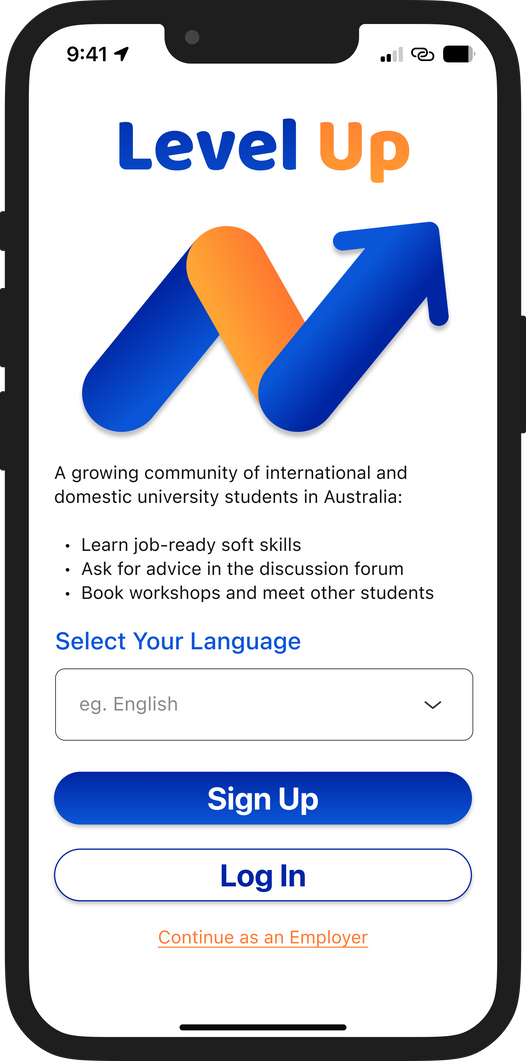
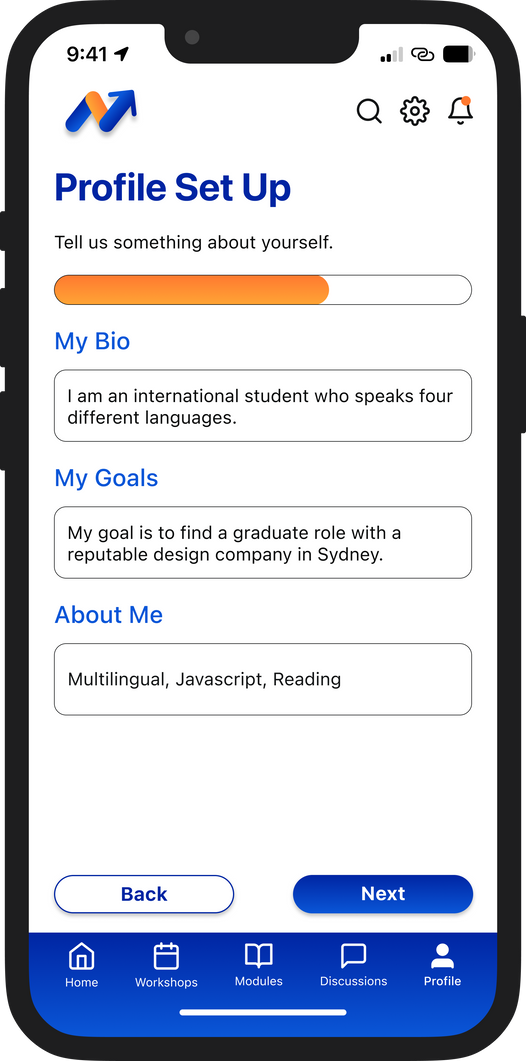
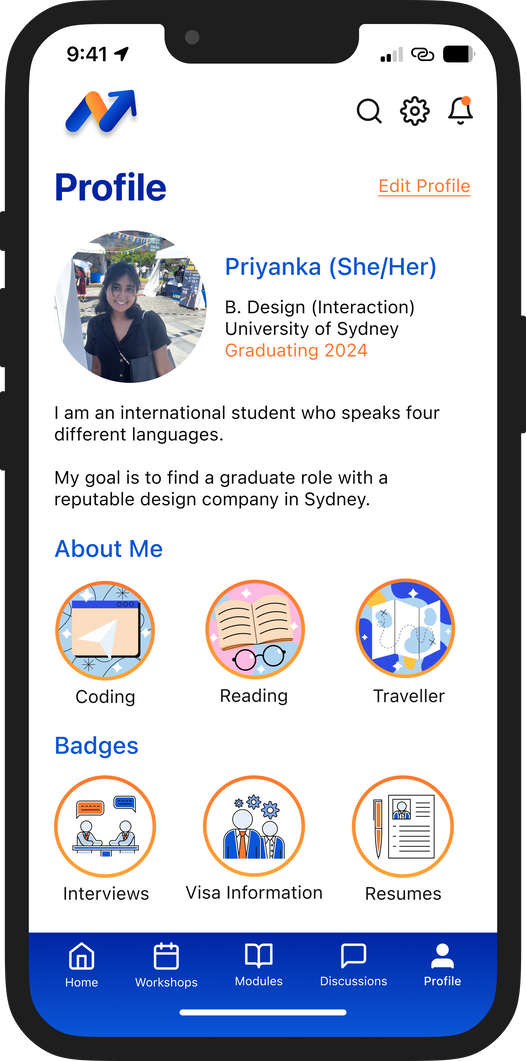

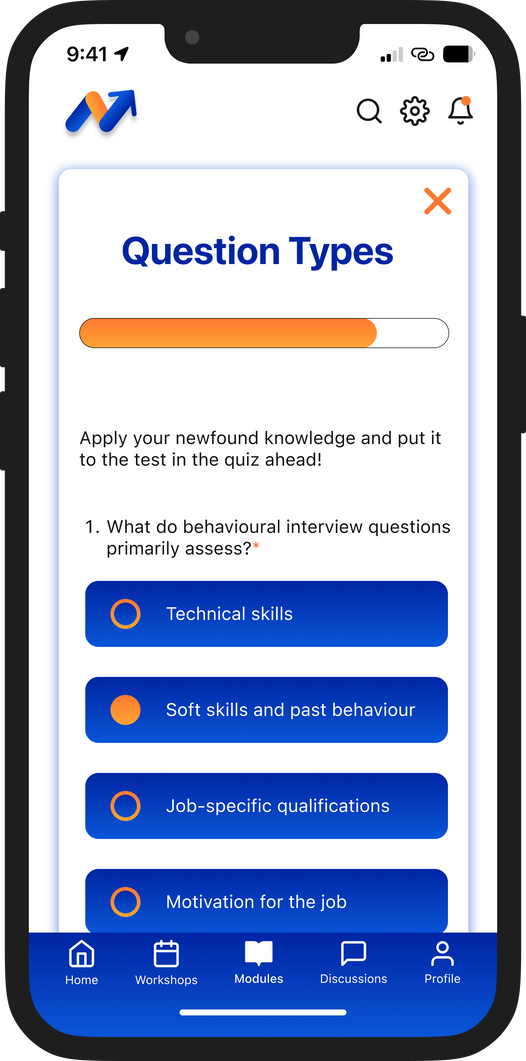
DECO2200 - Interaction Design Studio | |||
Project | Mobile Application & Public Kiosk | ||
Brief | As a group, choose a problem area positioned within a selection of categories and develop a digital solution that has visual, screen based components, includes social interactions between users, and includes multi-modal and/or omni-channel interactions. NOTE: This project was completed with Eva Mary Arun & Jana Plumm. | ||
Requirements |
| ||
Skills |
| ||
Final Product | Our proposed design solution bridges multiple gaps. Domestic and international students can improve their employability skills through accessible learning modules. They can socially interact and support each other in the discussions feature. They can also register for workshops organised informally by students or by the university, providing greater exposure to university career services. Employers can get a quick understanding of international students facts through fun mythbuster-like quizzes. They can also view student profiles and request to connect for work opportunities. | ||
Process | |||
RESEARCH Background Research - After selecting our choice of category options, ‘Cultural Harmony & Valuing Multiculturalism’, we researched specific areas that we could focus on within that space. Overall, our research found that international students face limited opportunities and employer hesitation, which makes them vulnerable to exploitation. Additionally, university career services don’t offer enough support and career fairs are primarily targeted at domestic students. We used the concerns found in our background research as the basis for how we conducted our research methods and developed the below research questions. Our methods included an online ethnography, interviews, a questionnaire and a contextual observation. Research Questions -
Online Ethnography - We gathered qualitative data in the form of quotes on Reddit threads and similar social forums. International students generally feel as though they are not valued in the Australian workforce. Additionally, I conducted a review of the services available at top universities in Australia, with a focus on international students. Interviews - A round of 8 semi-structured interviews were conducted with a mix of domestic and international students and a selection of professionals and hiring managers. The interviews found that employers are hesitant to hire due to temporary visa status and need stronger soft skills. Questionnaire - A 14 question questionnaire with a target of domestic and international students. There were a lot of similarities between the two groups and both rarely engage in uni networking events or career services. However, this appeared to be for differing reasons. Contextual Observation - A 60 minute observation of a University of Sydney Learning Hub session, “Interviewing for International Students”. This session was tailored at interviewing skills for international students. There was an impressive turnout with positive engagement, showing a clear need for these services. Findings - Our findings from the research methods conducted, lead to the the following six findings through an affinity diagram:
Refined Problem Statement - International students are underrepresented in the internship and graduate role space. Employers are hesitant to hire international students due to lack of understanding of work rights and need applicants with strong soft skills adapted to the Australian job market. International students want to build confidence and need university career services to be more visible and updated with current trends. How can we bridge the gap between these three stakeholders to improve international student employability in Australia? | |||
IDEATION Personas & Storyboards We each developed one persona based on our research, one for each of the significant stakeholders within our problem area; a current student, a recent graduate, and a hiring manager. A storyboard was created for each of these personas to better understand their experiences and problems. These personas were used throughout the development and ideation process. Reframing & Initial Ideation We conducted several reframing methods to ensure we understood our problem area sufficiently before we began our initial ideation process. These included 5 Whys and Questionstorming. Additionally, this is where our initial ideation phase began, we utilised Challenge Assumptions, Worst Possible Idea, Mindmapping and Moodboards to develop individual solutions. Decision Matrix & Ethics Canvas We each chose our favourite concept from our ideation sessions and compared them using a decision matrix. The decision matrix highlighted each of the concepts having positives and negatives while all having similar scores. From this we combined components of each idea into one multipurpose application. From here, we sketched out the chosen, combined solution and used an ethics canvas to addressed concerns we had for each component of the canvas to improve the overall concept. | |||
FINAL CONCEPT The final concept was an application where users were able to access resources to help improve their soft skills by receiving feedback on interview skills, complete modules about key considerations for the Australian job market trends, access discussions from other students surrounding feedback and available opportunities. Additionally, the solution will include a public display kiosk as the omni-channel component of the brief. | |||
WIREFRAMES & TESTING Wireframes were developed based on the initial sketches of the application main pages. These wireframes were required to be tested using a Think Aloud and SUS with users and a cognitive walkthrough with experts. These testing sessions provided fantastic feedback about about how and where to improve and develop the application further. Our SUS score of 77.8 indicated we had a lot of room for improvement. The results from each of our testing sessions indicated the Modules and Discussions sections were in need of the most attention. | |||
DESIGN SYSTEM We employed a 60-30-10 colour scheme, with white as the main colour, followed by blue and orange. These colours are not only complementary but are also suggested to boost productivity, and improve neural functioning. The specific colours changed multiple times with the addition of the gradient later on for more depth in the designs. This system informed the mockups we produced. | |||
PROTOTYPING & TESTING Once the inital mockups were complete, we prototyped them using Figma. We were required to test these using a Heuristic Evaluation with experts and another Think Aloud and SUS with users. This round of testing was a significant improvement from the wireframe stage and the required improvements for the mobile application were minimal. | |||
FINAL ITERATION Below is a selection of screens from the mobile application including sign up, home, profile, workshops and modules. | |||


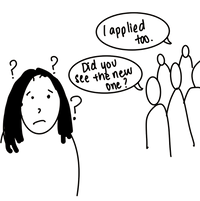
Priyanka learns that internships are common from her classmates. So she looks online to try and find out what she needs to have ready in order to apply. She decides she needs to get herself ready to apply for some to get more experience.

Priyanka answers the application questions and uploads the documents needed until she gets to a question regarding her residency status in Australia. She was not aware that it was possible for internships to exclude international students.
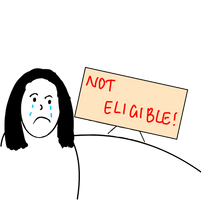
After finding out she isn’t eligible for this internship, she goes back to find a different one she can apply for. With limited success for companies who are willing to take on international students, she applies for the two companies she found but is feeling very disheartened.
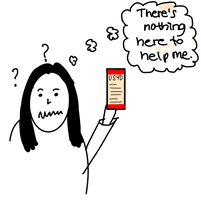
Uni
Priyanka heads to her university website to find more information about internships and international students but is unable to find any resources that help locate internships that are specific to her situation.

Feeling disappointed in her experience, she patiently awaits feedback from the two internships that she applied for.
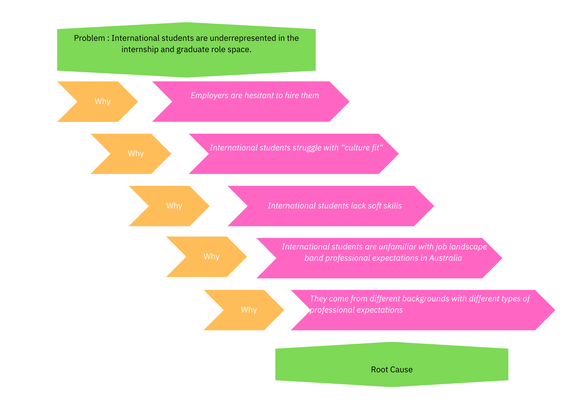

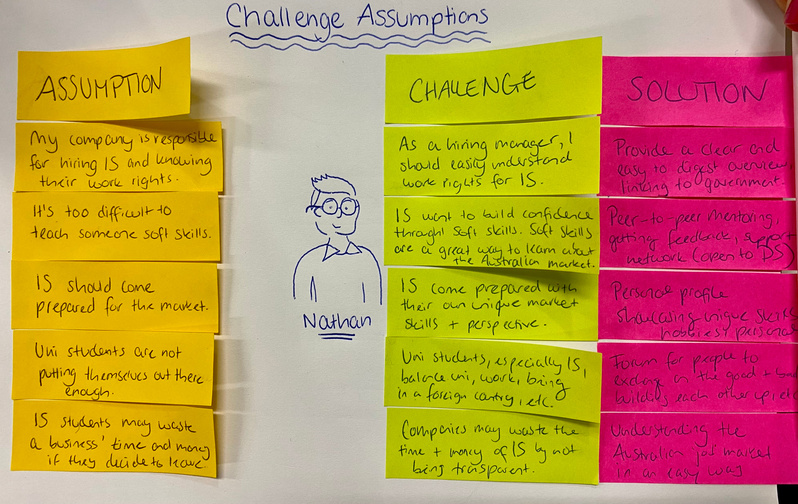

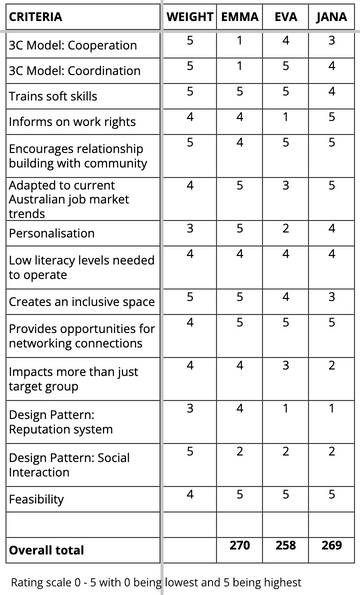
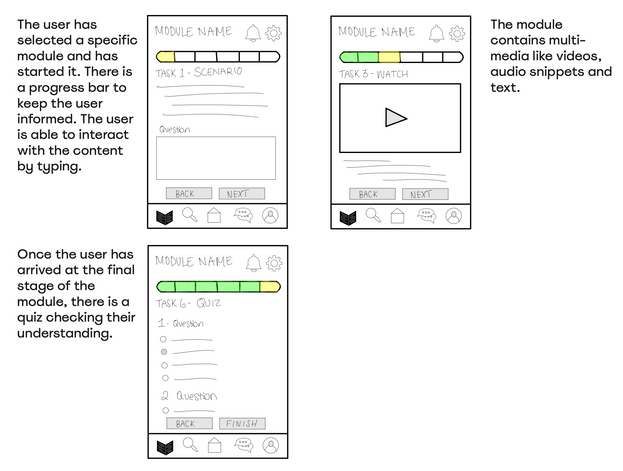
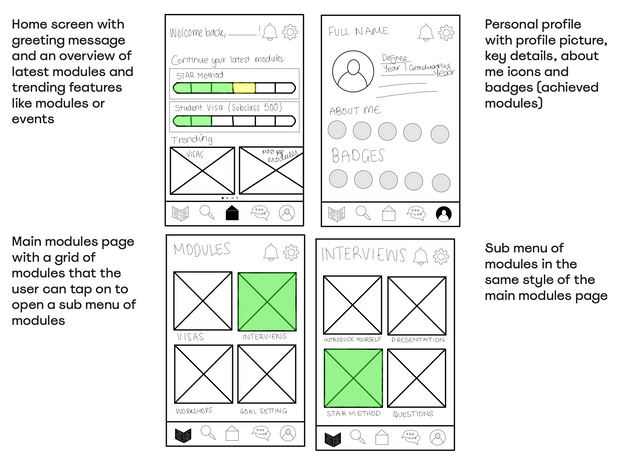
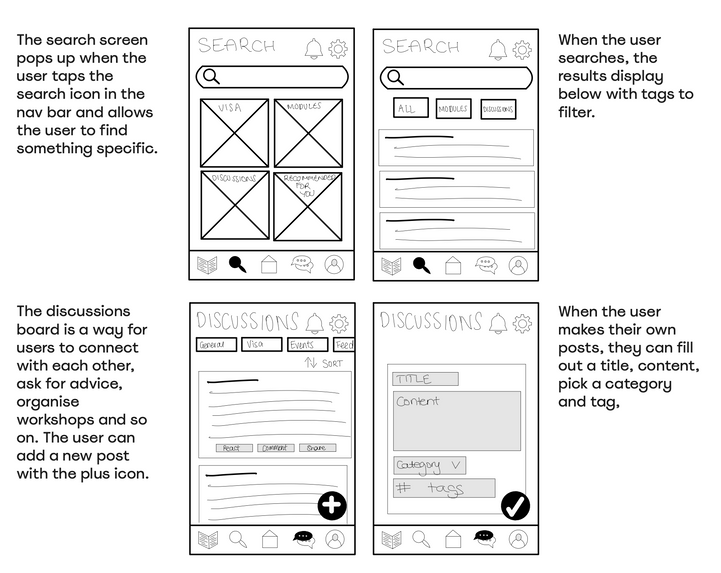

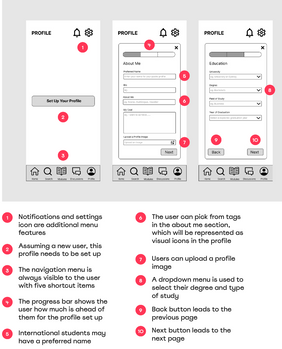

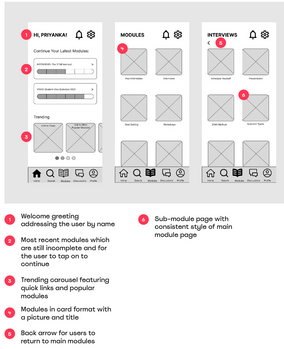
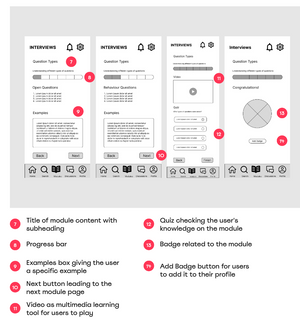
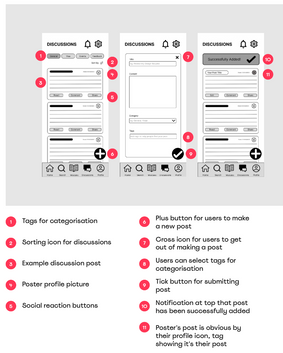
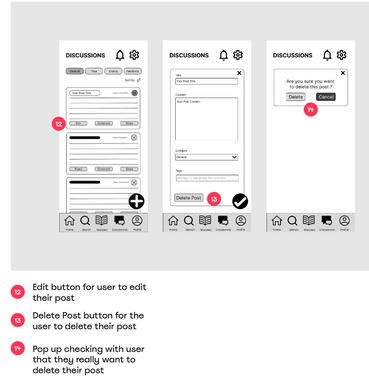
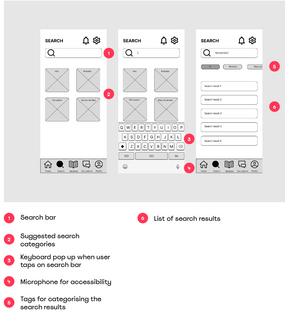
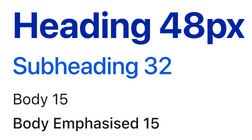


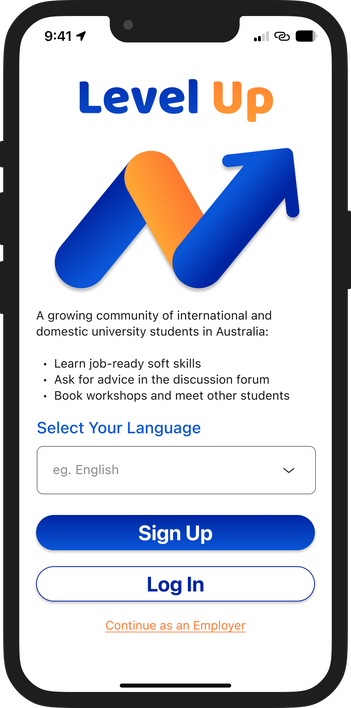
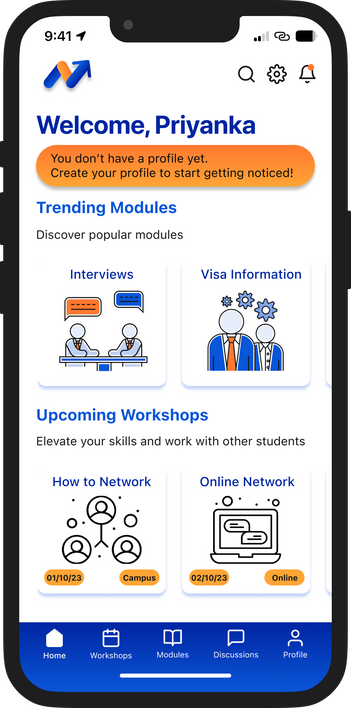

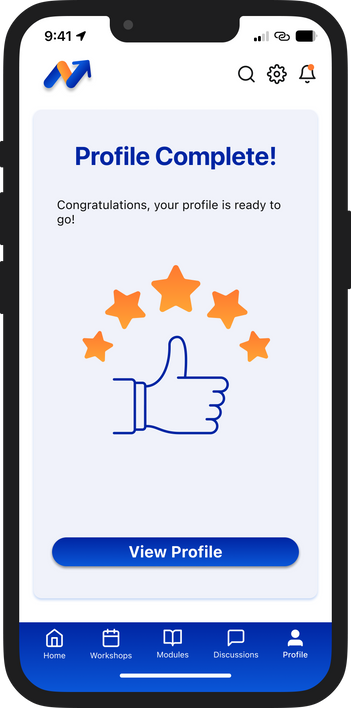
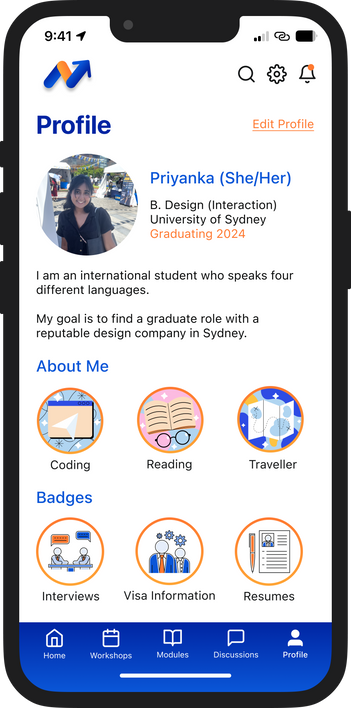
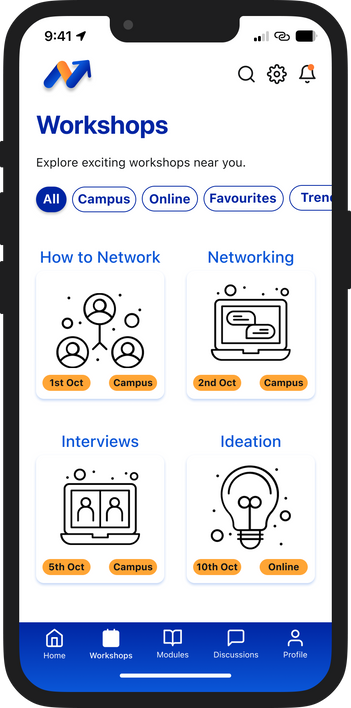
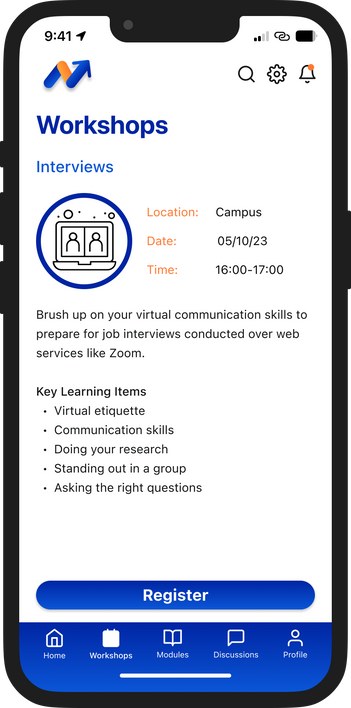


VISIT NELSON: Web Design
DECO1016 - Introduction to Web Design | ||
Project | Destination Microsite | |
Brief | Research, design and code a responsive and functional microsite of a chosen location. It should promote the community and cultural highlights of the area and encourage tourism to the location. | |
Requirements | Design:
| Prototype:
|
Skills |
| |
Product | ||
The final product is a four page microsite highlighting the sights of Nelson, New Zealand based on designs created through research on the area and known design principles and patterns. The site includes a home page, and three pages highlighting specific activities and places to visit under the categories - nature, adventure and culture. Nelson is a city on the south island of New Zealand, known for it's ecotourism and adventure tourism and considered the centre of New Zealand. It's an ideal tourist location due to the sun all year round, the airport located in the city, and the nature, adventure and cultural experiences available. The target group for the website is young Australians, those having just finished high school or in university. The close distance to Australia makes this a perfect holiday location, particularly after the reintroduction of international travel post-covid lockdowns. I imagine this site working in tandem with a consistent social media campaign which encourages users of the target user group to the website. The group is a good target to market to through social media. | ||
Process | ||
RESEARCH
DESIGN
PROTOTYPE
| ||
BOOK TRACKER: Web Dev
DECO2017 - Advanced Web Design | ||
Project | Single Page Tracking Website | |
Brief | Research, design and code a simplified prototype of a tracking website of a category of your choice. The tracked data should be displayed back to the user and able to be deleted - visually and from local storage. | |
Requirements | Design:
| Prototype:
|
Skills |
| |
Product | ||
Within the 'media consumption' category, I chose to create a website with the purpose of tracking the books a user reads. The fields I have selected contain both important information about the books and some key data which came from the insights of my user questionnaire. Data fields for the user to enter include:
From the questionnaire I completed, I got some opinions about what avid book readers would like to track about their reading habits. The target group for this website is "book readers aged between 24 and 34 who read 60+ books per year" The application aims to collect all useful information about each book the user reads, with some fields being required but allowing some freedom outside of the general information. | ||
Process | ||
RESEARCH
DESIGN
PROTOTYPE
| ||

